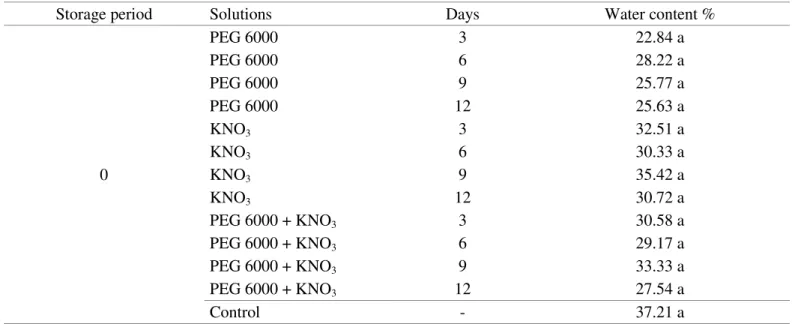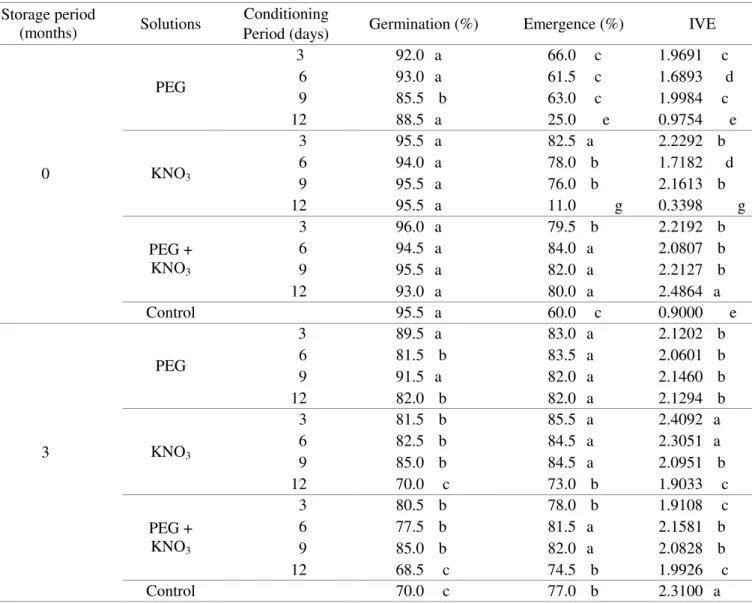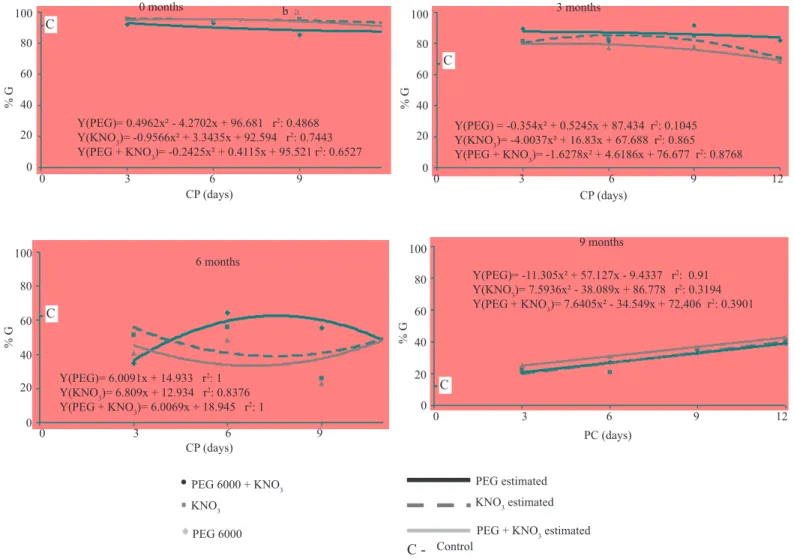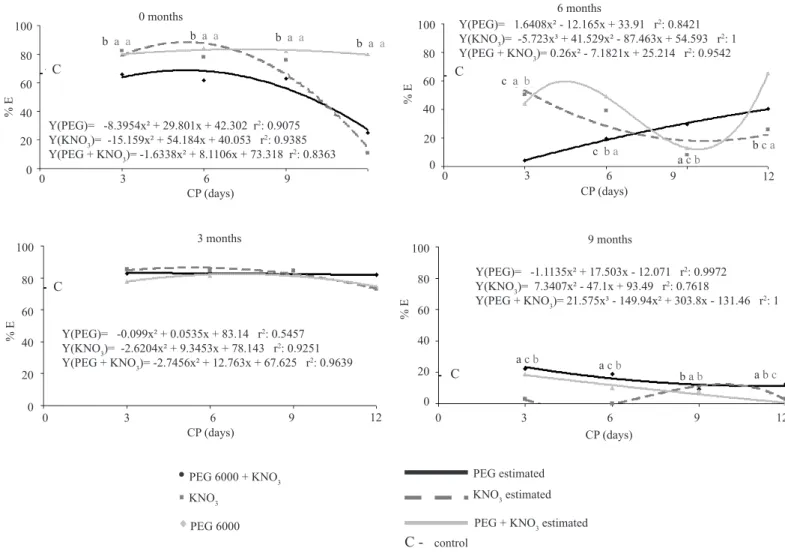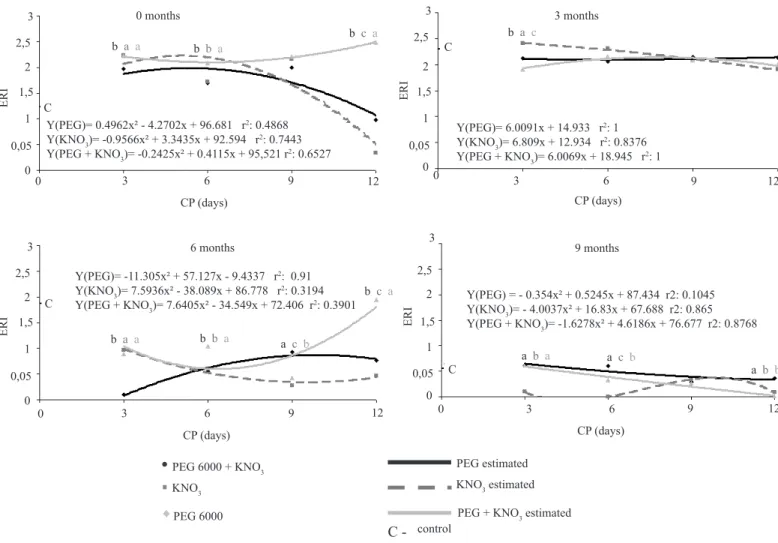1 Submetido em 19/03/2009. Aceito para publicação em 08/12/2009. 2 Eng. Agr., pós graduanda em Agronomia do Departamento de Agricultura/
Setor de Sementes, UFLA. e-mail: isis_bd@hotmail.com
3 Eng. Agr., Dr., professor Adjunto, Departamento de Agricultura, UFLA,
Caixa postal 37, CEP 37200-000. Lavras, MG. sementes@dag.ufla.br.
OSMOTIC PRIMING METHODOLOGIES IN RELATION TO
THE PHYSIOLOGICAL PERFORMANCE OF RANGPUR LIME
SEEDS
(Citrus limonia
Osbeck)
1Ísis Barreto Dantas1, renato MenDes GuiMarães2,
ÉDila Vilela De rezenDe Von Pinho3, Maria laene Moreira De CarValho3
ABSTRACT - Several mechanisms have been used to promote rapid germination of citrus seeds and uniform seedling emergence. We evaluated the effects of osmotic priming on the physiological performance of Rangpur lime seeds (Citrus limonia Osbeck). Seeds were treated with 30 g of Captan and 10 g of Tecto 600 in 20-litre batches and stored, without drying, at 10 °C and 50% relative humidity for periods of 3, 6 and 9 months. After each period, seeds were primed at 25 ºC, in the light, by immersion in poliethylenoglicol (pEG 6000), potassium nitrate (KNO3) and 70% pEG 6000 plus 30% KNO3, all at an osmotic potential of –1.1Mpa, for priming periods of 3, 6, 9 and 12 days. percentage germination, tray emergence and the emergence rate index (ERI) were evaluated. priming in pEG 6000 solution, independent of priming period, or in KNO3 or pEG 6000 plus KNO3 for up to
9 days, were efficient at improving the physiological performance of seeds stored for up to 3 months.
Osmotic priming appears to be a promising technique for improving the physiological quality of Rangpur lemon seeds.
Index terms: citrus, osmoconditioning, priming, storage.
METODOLOGIAS DE CONDICIONAMENTO OSMÓTICO NO DESEMpENHO FISIOLÓGICO DE SEMENTES DE LIMÃO CRAVO
RESUMO - Vários mecanismos têm sido utilizados para que sementes de citros possuam uma germinação rápida e tenham uniformidade de plantas. Neste trabalho teve-se por objetivo avaliar
metodologias de condicionamento osmótico no desempenho fisiológico de sementes de limão cravo
de KNO3 ou pEG 6000 + KNO3, por até 9 dias, são eficientes em recuperar a viabilidade das sementes armazenadas por até 3 meses. Sendo assim, a técnica do condicionamento osmótico é promissora para
melhorar a qualidade fisiológica de sementes de limão cravo.
Termos para indexação: osmocondicionamento, armazenamento, citros.
INTRODUCTION
One of the main aims of Brazilian citriculture is the
production of certified pathogen-free authenticated citrus
varieties for the production of vigorous and healthy seedlings. To this end, protected atmospheres are now used to grow seedlings from seeds and buds produced from healthy plants of known origin (Jabur and Martins, 2002).
Brazilian citriculture is concentrated in São paulo state where about 80% (14.8 million tonnes from 700 thousand hectares) of the countries oranges are grown, with 57% of the orange seedlings used being grafted onto rootstocks of Rangpur lime (Citrus limonia Osbeck) (Graf, 2009).
Citrus rootstocks are mainly produced from seeds, but the long germination period of 15 to 60 days, depending on the species, accounts for about 60% of the production time and the plantlets produced vary in size (Cohen, 1956; Monselise, 1962; platt and Optiz, 1973; Fucik, 1978; Mobayen and Milthorpe, 1978). The size-variation being undesirable because it hinders handling and increases production costs.
Osmotic priming has been used to promote rapid and uniform germination in species such as green peppers (Roveri José et al., 2000) cucumber (Lima e Marcos Filho, 2010)and coffee (Brandão Júnior et al., 2002). This technique is based on the controlled hydration of seeds to a level that allows pregerminative metabolic activity but inhibits radicular emergence, and is achieved by immersing seeds in an aqueous solution of a chemically inert but osmotically active compound. The osmotic potential is adjusted to allow all the pregermination processes while impeding cellular prolongation and hence radicular emergence, even after weeks of contact between the seeds and the osmotic solution (Heydecker et al., 1975; Khan, 1992).
During osmotic priming the seed is slowly moisturized and this allows more time for repair or reorganization of plasma membranes, which results in more orderly tissue formation and reduces the risk of damage to the embryonic axis caused by the fast-soak method (Khan, 1992). Several physiological changes happen in the seeds during, or as a
consequence of, osmotic priming, including the breaking of dormancy and increased germinative power and vigor (Khan, 1992).
Several benefits of osmotic priming have been
cited, one of which is an increased probability of fast emergence, particularly under stresses such as hydric
deficit or inadequate temperature (Eira and Marcos Filho,
1990). Furthermore, because osmotic priming increases the uniformity of germination and emergence seedlings
establish more rapidly in the field and the planning and
execution of cultivation and harvesting is facilitated. However, there are few reports of the use of osmotic priming in citrus species, suggesting the need for more research in this area with the view to developing techniques which can be adapted to the production of high-quality citrus seedlings. The objective of the work described in this paper evaluated the relationship between osmotic priming methodologies and the physiological performance of Rangpur lime seeds used in the production of citrus rootstocks.
MATERIAL AND METHODS
The experiment was conducted at the Seed Analysis Laboratory at the Federal University, Lavras, Minas Gerais, Brazil.
Rangpur lime (Citrus limonia Osbeck) seeds,
purchased from/donated by Cutrale®, were treated with 30
g of Captan (Milenia Agro Ciências S.A.) and 10 g of Tecto 600 (Syngenta) per 20-litres of seeds and stored, without drying (seed moisture content (MC) = 62.8%), in 4.5-litres samples in impermeable polyethylene sacks (Carvalho et al., 2002) for four storage periods (0, 3, 6 and 9 months), the 3, 6 and 9 month batches being stored in a cold chamber at 10 ºC and 50% RH and the unstored. The water content of the seeds was evaluated during storage by drying at 105 °C±3 °C for 24 hours according to the Rules for Seed Testing, (Brasil, 1992).
After each storage period, the seeds were osmotically primied by immersion for 3, 6, 9 or 12 days in aerated liquid
polyethylene glycol 6000 pEG (CAS Number 71767-64-1, Dow), aqueous potassium nitrate (KNO3) or 70% pEG 600 plus 30% KNO3, all adjusted to an osmotic potential of –1.1 Mpa. The priming was carried out in a biological oxygen demand (BOD) chamber at 25 ºC in the presence of light. After each priming period, samples of primed seeds were removed, washed in water and evaluated by standard germination test and the tray emergence test. The emergence rate index (ERI) was also calculated using the tray emergence test data. Four replicates were made for each test and the controls were dry unprimed seeds (RH = 62.8%) stored for the same time under the same conditions (10 ºC and 50% RH).
In the germination test 50 tegumented seeds were placed on towel paper moistened with distilled water (2.5 times the dry weight of the paper) and placed in a germination chamber set at 25 ºC, in the light, for 30 days (Brasil, 1992). Seeds producing at least one exposed leaf and primary roots of at least 3 cm were considered normal. The results were expressed as germination percentage.
For the tray emergence test, 50 tegumented seeds were sown in plastic trays (442 mm length x 280 mm width x 75 mm height) containing a 2:1 soil:sand substrate moistened to 70% water retention capacity. After sowing, the trays were placed in a growth chamber set at 25 °C under a 12 hour dark/light cycle for 30 days, after which the percentage of normal seedlings with an exposed leaf
at least 3 cm above the soil was recorded. The ERI was also calculated according to Maguire (1962) and daily counts of normal seedling emergence from immersed seeds, counting being started on the first day of emergence and continuing until the stabilization of the stands on day 40.The experimental design was a completely randomized factorial (4 x 3 x 4) with four storage times (0, 3, 6, 9 months), three solutions (pEG, KNO3 and 70%
pEG plus 30% KNO3) and four priming periods (3, 6, 9
and 12 days), the control being dry untreated seeds (RH = 62.8%) stored under the same conditions (10 ºC and 50% RH). Data were subjected to analysis of variance and means compared by the Scott-Knott test at the 5% probability level for qualitative characteristics and by regression analysis for quantitative traits.
RESULTS AND DISCUSSION
The seed water-content means showed no statistically
significant difference (Table 1), indicating that, independent
of the solute and the time of imbibition, osmotic priming did not affect water absorption. Water normally enters seeds rapidly, hindering cell membrane restoration, but osmotic priming reduces initial imbibition and provides more time for membrane repair or reorganization and thus increased germination and vigor.
Storage period Solutions Days Water content %
0
PEG 6000 3 22.84 a
PEG 6000 6 28.22 a
PEG 6000 9 25.77 a
PEG 6000 12 25.63 a
KNO3 3 32.51 a
KNO3 6 30.33 a
KNO3 9 35.42 a
KNO3 12 30.72 a
PEG 6000 + KNO3 3 30.58 a
PEG 6000 + KNO3 6 29.17 a
PEG 6000 + KNO3 9 33.33 a
PEG 6000 + KNO3 12 27.54 a
Control - 37.21 a
continued...
Means followed by the same letter do not differ by the Scott-Knott test at the 5% probability level.
Storage period
(months) Solutions
Conditioning
Period (days) Germination (%) Emergence (%) IVE
6
PEG
3 35.0 g 4.0 i 0.1048 h
6 64.5 c 19.5 g 0.5508 f
9 55.5 e 29.5 f 0.9290 e
12 40.0 g 40.5 e 0.7702 f
KNO3
3 51.5 f 50.5 d 0.9726 e
6 56.0 e 39.0 e 0.6071 f
9 26.0 h 8.0 i 0.2726 g
12 61.0 d 26.0 f 0.4641 g
PEG + KNO3
3 41.0 g 44.0 e 0.8901 e
6 48.5 f 49.0 d 1.0418 e
9 23.0 h 13.0 h 0.4230 g
12 61.5 d 65.5 c 1.9495 c
Control 65.6 d 64.5 c 1.9500 c
9
PEG
3 21.0 i 22.5 f 0.6167 f
6 27.0 i 19.0 g 0.5985 f
9 33.0 h 9.5 h 0.2925 g
12 39.0 h 12.5 h 0.3668 g
KNO3
3 23.0 i 3.0 j 0.0996 h
6 21.0 i 0.0 j 0.0000 h
9 35.0 h 11.5 h 0.3417 g
12 41.0 h 3.0 j 0.0922 h
PEG + KNO3
3 25.0 h 19.0 g 0.6137 f
6 31.0 h 10.0 h 0.3246 g
9 37.0 h 8.0 i 0.2618 g
12 43.0 h 0.0 j 0.0000 h
Control 13.5 i 13.0 h 0.4200 g
The slow germination of citrus seeds has been attributed to the mechanical barriers of the testa and tegmen (Soares Filho et al., 1995) and removal of the tegument has been suggested by Silva (2006) as a means of increasing the speed of germination in the citrus rootstock Swingle citrumelo (Citrus paradisi Macf.×Poncirus trifoliata L. Raf.). However, in Rangpur lime and Trifoliate Orange (Poncirus trifoliata, syn. Citrus trifoliata), another citrus rootstock, removal of the tegument showed no effect on germination (Ramos et al., 1991). In our experiments with tegumented Rangpur lime seeds, germination occurred mostly between 5 and 30 days after the start of testing, indicating that osmotic priming can speed up the
germination of these seeds even without the removal of the tegument.
In our experiments, there was a significant triple effect
interaction for osmotic priming in regard to the effects of different storage periods, solutes and priming periods on the germination performance of Rangpur lime seeds. Our results showed a constancy in the percentage germination of unstored seeds (i.e. 0 months, Figure 1). There was
no statistically significant difference in the germination
of seeds regarding the priming solute regardless of the priming period, except when seeds were primed for 9 days in pEG 6000, when germination was lower than with the other and solutes and the control (Table 2).
TABLE 2. Mean percentage germination, emergence index and emergence rate index (ERI) for Rangpur lime seeds stored for various periods and then primed with solutes for different periods. Values for untreated controls also shown.
continued...
Storage period
(months) Solutions
Conditioning
Period (days) Germination (%) Emergence (%) IVE
0
PEG
3 92.0 a 66.0 c 1.9691 c
6 93.0 a 61.5 c 1.6893 d
9 85.5 b 63.0 c 1.9984 c
12 88.5 a 25.0 e 0.9754 e
KNO3
3 95.5 a 82.5 a 2.2292 b
6 94.0 a 78.0 b 1.7182 d
9 95.5 a 76.0 b 2.1613 b
12 95.5 a 11.0 g 0.3398 g
PEG +
KNO3
3 96.0 a 79.5 b 2.2192 b
6 94.5 a 84.0 a 2.0807 b
9 95.5 a 82.0 a 2.2127 b
12 93.0 a 80.0 a 2.4864 a
Control 95.5 a 60.0 c 0.9000 e
3
PEG
3 89.5 a 83.0 a 2.1202 b
6 81.5 b 83.5 a 2.0601 b
9 91.5 a 82.0 a 2.1460 b
12 82.0 b 82.0 a 2.1294 b
KNO3
3 81.5 b 85.5 a 2.4092 a
6 82.5 b 84.5 a 2.3051 a
9 85.0 b 84.5 a 2.0951 b
12 70.0 c 73.0 b 1.9033 c
PEG +
KNO3
3 80.5 b 78.0 b 1.9108 c
6 77.5 b 81.5 a 2.1581 b
9 85.0 b 82.0 a 2.0828 b
12 68.5 c 74.5 b 1.9926 c
Storage period
(months) Solutions
Conditioning
Period (days) Germination (%) Emergence (%) IVE
6
PEG
3 35.0 g 4.0 i 0.1048 h
6 64.5 c 19.5 g 0.5508 f
9 55.5 e 29.5 f 0.9290 e
12 40.0 g 40.5 e 0.7702 f
KNO3
3 51.5 f 50.5 d 0.9726 e
6 56.0 e 39.0 e 0.6071 f
9 26.0 h 8.0 i 0.2726 g
12 61.0 d 26.0 f 0.4641 g
PEG + KNO3
3 41.0 g 44.0 e 0.8901 e
6 48.5 f 49.0 d 1.0418 e
9 23.0 h 13.0 h 0.4230 g
12 61.5 d 65.5 c 1.9495 c
Control 65.6 d 64.5 c 1.9500 c
9
PEG
3 21.0 i 22.5 f 0.6167 f
6 27.0 i 19.0 g 0.5985 f
9 33.0 h 9.5 h 0.2925 g
12 39.0 h 12.5 h 0.3668 g
KNO3
3 23.0 i 3.0 j 0.0996 h
6 21.0 i 0.0 j 0.0000 h
9 35.0 h 11.5 h 0.3417 g
12 41.0 h 3.0 j 0.0922 h
PEG + KNO3
3 25.0 h 19.0 g 0.6137 f
6 31.0 h 10.0 h 0.3246 g
9 37.0 h 8.0 i 0.2618 g
12 43.0 h 0.0 j 0.0000 h
Control 13.5 i 13.0 h 0.4200 g
Means followed by the same letter do not differ by the Scott-Knott test at the 5% probability level.
After 3 months storage, there was a statistically
significant difference in regard to solute and priming
period (Figure 1). With pEG 6000 as solute, the percentage germination was about 85% of normal seedlings, representing a 15% gain compared to the control (Table 2), demonstrating the potential use of this technique for increasing the percentage germination of fruit tree species.’
At 6 months, the percentage germination of control seeds was, in general, less than that of primed seeds, with
only priming for 6 days with pEG 6000 solution or 12 days with KNO3 alone orpEG 6000 plus KNO3 giving percentage germination levels similar to those of control seeds. These results indicate that osmoconditioning under
the conditions used can be inefficient at some storage
periods. However, considering that the results at 9 months (see below) gave gains in percentage germination for primed as opposed to unprimed seeds it is probable that the results at 6 months were anomalous due to some unknown factor, further research been needed to clarify this.
Different letters indicate significant differences between the solutes in each conditioning period.
FIGURE 1. Estimated seed germination (% G) for Rangpur lime seeds stored for 0, 3, 6 and 9 months primed with solutions of PEG 6000, KNO3 and PEG 6000 plus KNO3 for various conditioning periods (3, 6, 9 and 12 days).
100
100 100
100 b a a
0 months 3 months
80
80 80
80 60
60 60
60 40
40
40 40 20
20
20 20 0
0
0 0 0
0
0 0 3
3
3 3 6
6
6 6 Cp (days)
Cp (days)
pC (days) Cp (days) 9
9 6 months
9 months
Y(pEG)= -11.305x² + 57.127x - 9.4337 r2: 0.91
Y(KNO3)= 7.5936x² - 38.089x + 86.778 r 2: 0.3194
Y(pEG + KNO3)= 7.6405x² - 34.549x + 72,406 r2: 0.3901
9 12
9 12
% G
% G % G
% G
Y(pEG)= 0.4962x² - 4.2702x + 96.681 r2: 0.4868
Y(KNO3)= -0.9566x² + 3.3435x + 92.594 r 2: 0.7443
Y(pEG + KNO3)= -0.2425x² + 0.4115x + 95.521 r2: 0.6527
Y(pEG)= 6.0091x + 14.933 r2: 1
Y(KNO3)= 6.809x + 12.934 r 2: 0.8376
Y(pEG + KNO3)= 6.0069x + 18.945 r2: 1
Y(pEG) = -0.354x² + 0.5245x + 87.434 r2: 0.1045
Y(KNO3)= -4.0037x² + 16.83x + 67.688 r2: 0.865
Y(pEG + KNO3)= -1.6278x² + 4.6186x + 76.677 r 2: 0.8768
After 9 months storage there was a tendency towards increased percentage germination in relation to unprimed seeds, with this effect depending on the priming period but being independent of the solute (Figure 1). priming appeared to reverse the effects of storage, with increased percentage germination indicating metabolic recovery of the seeds. The most favorable results were obtained, regardless of the priming solute, after 6, 9 and 12 days priming, with gains of up to 44% compared to unprimed control seeds (Table 2). However, overall, seeds stored for 9 months gave the lowest percentage germination, i.e., there was a tendency to decreased percentage germination
for primed seeds regardless of the solute or priming period,
confirming the tendency of seeds of the species tested to
lose quality during storage.
The reduced percentage germination which occurred after 6 months storage, even in primed seeds may have been due to the moisture content of the seeds. Condensation was observed in the packages with a consequent increase in deterioration of the seeds during further storage as evidenced by the decay of some of the seeds.
The percentage tray emergence of unstored seeds (0 months storage) tended to increase until the 6th day of priming, independent of solute (Figure 2). However, from
pEG 6000 + KNO3 pEG estimated
KNO3 KNO3 estimated
pEG 6000 pEG + KNO3 estimated
Control C - C
C
the 9th day of priming there was a decrease in percentage tray emergence, but this decrease was reduced when the priming solute was pEG 6000 or KNO3. For 3, 6 and 9 days of priming KNO3 or pEG 6000 plus KNO3, were the most efficient priming
agents, producing higher percentage tray emergence than that seen with unprimed control seeds. After 12 days priming, only pEG 6000 plus KNO3 was efficient in maintaining the percentage tray emergence values (Table 2).
100 0 months 100
6 months
80 80
60 60
40 40
20 20
0 0
0 3 6 0 3 6
Cp (days) Cp (days)
9 9 12
% E
% E
Y(pEG)= -8.3954x² + 29.801x + 42.302 r2: 0.9075
Y(KNO3)= -15.159x² + 54.184x + 40.053 r 2: 0.9385
Y(pEG + KNO3)= -1.6338x² + 8.1106x + 73.318 r2: 0.8363
Y(pEG)= 1.6408x² - 12.165x + 33.91 r2: 0.8421
Y(KNO3)= -5.723x³ + 41.529x² - 87.463x + 54.593 r 2: 1
Y(pEG + KNO3)= 0.26x² - 7.1821x + 25.214 r2: 0.9542
b a a b a a b a a b a a
c a b
c b a
a c b
b c a
100 100
80 80
60 60
40 40
20 20
0 0
0 3 6 0 3 6
Cp (days) Cp (days)
9
3 months 9 months
Y(pEG)= -1.1135x² + 17.503x - 12.071 r2: 0.9972
Y(KNO3)= 7.3407x² - 47.1x + 93.49 r2: 0.7618
Y(pEG + KNO3)= 21.575x³ - 149.94x² + 303.8x - 131.46 r 2: 1
9 12
12
% E
% E
Y(pEG)= -0.099x² + 0.0535x + 83.14 r2: 0.5457
Y(KNO3)= -2.6204x² + 9.3453x + 78.143 r2: 0.9251
Y(pEG + KNO3)= -2.7456x² + 12.763x + 67.625 r 2: 0.9639
a b c
b a b
a c b
a c b
Different letters indicate significant differences between the solutes in each conditioning period
FIGURE 2. Estimated percentage of emergence (% E) for Rangpur lime seeds stored for 0, 3, 6 and 9 months primed with solutions of PEG 6000, KNO3 and PEG 6000 plus KNO3 for various conditioming periods (3, 6, 9 and 12 days).
We found that increased priming time led to a reduction in the effectiveness of priming irrespective of solute,
indicating that short priming times are more efficient for
osmoconditioning. This is supported by the work of Del Giúdice et al. (1998), who reported that soybean (Glycine max) seeds showed better emergence and increased ERI when primed at 25 °C for 4 days in -0.8 Mpa pEG 6000.
At 3 months we found a linear trend in the constancy of emergence until the 9th day of priming for all solutes,
while at 12 days there was a tendency to reduced emergence when the priming solutes were pEG 6000 or KNO3 (Figure 2). Figure 2 shows that, in general, the
priming treatments were efficient and produced higher
levels of seedling emergence as compared to unprimed control seeds, the exceptions being priming for 12 days
with KNO 3 and 3 or 12 days with pEG 6000 plus KNO3
which resulted in seedling emergence values which did not differ with those from unprimed control seeds. There
pEG 6000 + KNO3 pEG estimated
KNO3 KNO3 estimated
pEG 6000 pEG + KNO3 estimated
control C - C
C C
C
was a tendency to increased percentage emergence at 3 months for seeds primed with pEG 6000 or KNO3, irrespective of the priming period, but this was followed by a sharp decline with increasing storage. This indicates that although the seeds used were recalcitrant and could not tolerate long-term storage when the priming is used after short-term storage it can result in the recuperation and recovery of the vigor of the seed lot. Since the 3 month emergence values for seeds treated with pEG 6000 and KNO3 were higher than for unstored seeds, priming
with these solutes is an efficient method for recuperating
vigor, especially for low-quality seed lots.
After 6 and 9 months storage, unprimed control seeds produced higher emergence values than the primed seeds (Figure 2), indicating that priming was ineffective in
recuperating the emergence capacity of seeds stored for long periods.
The ERI for unstored seeds increased up to the 6th day of priming, independent of the solute used (Figure 3), after which only pEG 6000 plus KNO3 maintained high ERI values. Analysis of mean values showed that priming with pEG 6000 for 6 days or KNO3 for 12 days, produced ERI values less than or equal to unprimed controls, with the highest ERI values occurring with the other treatments, with the largest ERI values occurring when the seeds were primed for 12 days in pEG 6000 plus KNO 3 (Table 2). Tomato seeds have been reported as showing shorter emergence times and higher percentage when treated at 16 º C for 8 days with -1.2 Mpa pEG 4000 (Muhyaddin and Wiebber, 1989 cited by Dias et al ., 1999).
Different letters indicate significant differences between the solutes in each conditioning period
FIGURA 3. Estimate the index of germination speed (SEI) of Rangpur lime seeds, stored for 0, 3, 6 and 9 months, depending on the priming solution containing solute (PEG 6000, PEG 6000 + KNO3 and KNO3) and conditioning period (3, 6, 9 and 12 days).
9 12
3 0 months 3 3 months
2,5 2,5
2 2
1,5 1,5
1 1
0,05 0,05
0 0
0 3 6 0 3 6
Cp (days) Cp (days)
9 12
ERI ERI
Y(pEG)= 0.4962x² - 4.2702x + 96.681 r2: 0.4868
Y(KNO3)= -0.9566x² + 3.3435x + 92.594 r 2: 0.7443
Y(pEG + KNO3)= -0.2425x² + 0.4115x + 95,521 r2: 0.6527
Y(pEG)= 6.0091x + 14.933 r2: 1
Y(KNO3)= 6.809x + 12.934 r2: 0.8376
Y(pEG + KNO3)= 6.0069x + 18.945 r 2: 1
b a a
b c a b a c
b b a
9 12
12
3 3
2,5 2,5
2 2
1,5 1,5
1 1
0,05 0,05
0 0
0 3 6 0 3 6
Cp (days) Cp (days)
9 12
6 months 9 months
Y(pEG) = - 0.354x² + 0.5245x + 87.434 r2: 0.1045 Y(KNO3)= - 4.0037x² + 16.83x + 67.688 r2: 0.865 Y(pEG + KNO3)= -1.6278x² + 4.6186x + 76.677 r2: 0.8768
ERI ERI
Y(pEG)= -11.305x² + 57.127x - 9.4337 r2: 0.91
Y(KNO3)= 7.5936x² - 38.089x + 86.778 r 2: 0.3194
Y(pEG + KNO3)= 7.6405x² - 34.549x + 72.406 r2: 0.3901
b a a b b a a c b
b c a
a b a a c b
a b b
pEG 6000 + KNO3 pEG estimated
KNO3 KNO3 estimated
pEG 6000 pEG + KNO3 estimated
control C - C
C
C
We also found that at 3 months storage there was an increasing trend in the ERI when seeds were primed in pEG 6000 or pEG 6000 plus KNO3 but a reduction in ERI when KNO3 was the priming solute (Figure 3). The highest ERI values were observed for unprimed control seeds and seeds primed for 3 days or 6 days KNO3 solution containing, which produced the higher ERI values than the other treatments. After 6 months storage there was a sharp decline in the ERI, with unprimed control seeds showing higher ERI values than all the treatments except for 12 days
priming in pEG 6000 plus KNO3.
For seeds stored for 9 months and then primed with pEG 6000 or pEG 6000 plus KNO3 and for unprimed controls the
ERI values were higher than for seeds primed with KNO3
for 6 days (Figure 3). Seeds primed for 9 days showed reduced ERI values with pEG 6000 and pEG 6000 plus KNO3 but increased ERI values with KNO3, although there
was no significant difference between these treatments. The
highest IVE values occurred when seeds were primed for 3 and 6 days in pEG 6000. The second highest values were for the untreated controls, theses values being higher than those for the other treatments.
The tray emergence test results and the ERI results were similar for all the priming periods and for the seeds primed in pEG 6000 or KNO3, showing a tendency to increase the
percentage emergence in the 3rd month of storage followed by a strong reduction in the other periods.
CONCLUSIONS
priming is a promising technique for improving the physiological quality of Rangpur lime seeds. Treatment with aerated pEG 6000, regardless of the priming period, or KNO 3 and pEG 6000 plus KNO 3 for up to 9 days, are effective in recovering the viability of seeds of Rangpur lime seeds stored for up to 3 months.
REFERENCES
BRASIL. Ministério da Agricultura e Reforma Agrária. Secretaria Nacional de Defesa Agropecuária. Departamento Nacional de Defesa Vegetal. Coordenação de Laboratório Vegetal. Regras para análise de sementes. Brasília, DF, 1992. 365p.
BRANDÃO JUNIOR, D. da S.; VIEIRA, M. das G.G.C.; GUIMARÃES, R.M. HILHORST, H.W.M. Tolerância à dessecação de sementes de cafeeiro (Coffea arabica, L.).
Revista Brasileira de Sementes, v.24, n.2, p.17-23, 2002.
CARVALHO, J.A.; pINHO, E.V.R.V.; OLIVEIRA, J.A.; GUIMARÃES, R.M.; BONOME, L.T. Qualidade de sementes de limão-cravo (Citrus limonia Osbeck) durante o armazemanento. Revista Brasileira de Sementes, v.24, n.1, p.286-298, 2002.
COHEN, A. Studies on the viability of citrus seeds and certain properties of their coats. Israel Journal of Botany, v.7, p. 69-80, 1956.
DEL GIÚDICE, M.p.; REIS, M.S.; SEDIYAMA, C.S.; SEDIYAMA, T.; MOSQUIM, p.R. Avaliação da
qualidade fisiológica de sementes de soja submetidas ao
condicionamento osmótico em diferentes temperaturas.
Revista Brasileira de Sementes, v.20, n.2, p.16-24, 1998.
DIAS, D.C.F.S.; pAIXÃO, G.p.; SEDIYAMA, M.A.N.; CECON, p.R.C. pré-condicionamento de sementes de
quiabo: efeitos na qualidade fisiológica e no potencial de
armazenamento. Revista Brasileira de Sementes, v.21, n.2, p.224-231, 1999.
EIRA, M.T.S.; MARCOS FILHO, J. Condicionamento osmótico em sementes de alface: efeitos sobre a germinação.
Revista Brasileira de Sementes, v.12, n.1, p.9-27, 1990.
FUCIK, J.E. Sources of variability in sour orange seed germination and seedling grouwth. Proceeding International Society Citriculture, n.1, p.141-143, 1978.
GRAF, C.C.D. The citrus nursery industry in
Brazil. INTERNATIONAL CONGRESS OF CITRUS NURSERYMEN, 8th., China. China: Chongqing Rp, 2008.
Disponível em: <http://www.citrograf.com.br/informacoes_ palestras.html>. Acesso em: 20 jan. 2009.
HEYDECKER, W.; HIGGINS, J.; TURNER, Y.J. Invigoration of seeds. Seed Science & Technology, v.3, n.3/4, p.881-888, 1975.
JABUR, M.A.; MARTINS, A.B.G. Influência de substratos
na formação dos porta-enxertos: limoeiro-cravo (Citrus limonia Osbeck) e tangerina - cleópatra (Citrus reshni Hort.
Ex Tanaka) em ambiente protegido. Revista Brasileira de
Fruticultura, v.24, n.2, p.514-518, 2002.
KHAN, A.A. preplant physiological seed conditioning.
Horticultural Review,v.13, p.131-181, 1992.
LIMA, L.B. MARCOS FILHO, J. Condícionamento
fisiológico de sementes de pepino e germinação sob
diferentes temperaturas. Revista Brasileira de Sementes, v.32, n.1, pag 138-147, 2010.
MAGUIRE, J.D. Speed of germination aid in selection and evaluation for seedling and vigour. Crop Science, v.2, n.2, p.176-177, 1962.
MOBAYEN, R.G.; MILTHORpE, F.L. Citrus seed
germination as influenced by water potential and salinity.
Proceedings International Society Citriculture, v.1, p.247-249, 1978.
MONSELISE, S.p. Citrus seed biology. In:
INTERNATIONALL HORTICULTURAL CONGRESS, 16., 1962, Brussels. Proceedings... Brussels, 1962. v.5, p.559-565.
pLATT, R.G.; OpITZ, K.W. propagation of citrus. In: REUTHER, W. (Ed.). The citrus industry. Berkeley: University of California Agricultura, 1973, v.3, p.1- 47.
RAMOS, J.D.; SERGIO, A.C.; pASQUAL, M. Efeito da extração do tegumento na expressão poliembriônica de sementes de dois porta-enxertos cítricos. Revista Brasileira de Fruticultura, v.13, n.1, p.161-166, 1991.
ROVERI JOSÉ, S.C.B.; VIEIRA, M. das G.G.C.; GUIMARÃES, R.M. Efeito da temperatura e do período de condicionamento osmótico na germinação e no vigor de sementes de pimentão. Revista Brasileira de Sementes, v.22, n.2, p.176-184, 2000.
SILVA, T.T. de A. Conservação de sementes de
citrumelo ‘Swingle’ colhidas em diferentes estádios de maturação submetidas a tratamentos fungicidas. 2006. 55f. Dissertação (Mestrado em Fitotecnia) – Universidade Federal de Lavras, Lavras, 2006.
SOARES FILHO, W.S.; LEE, M.; CUNHA SOBRINHO,
A.P. da; Influence of pollinators on polyembryony in Citrus.
